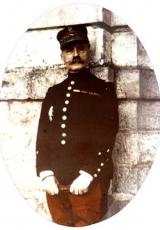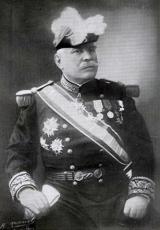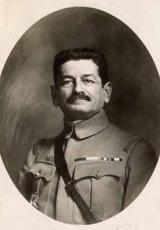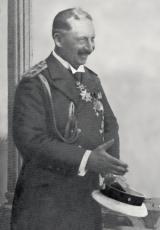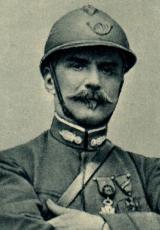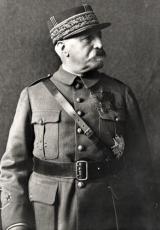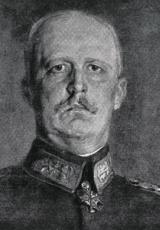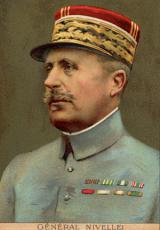La bataille de Verdun
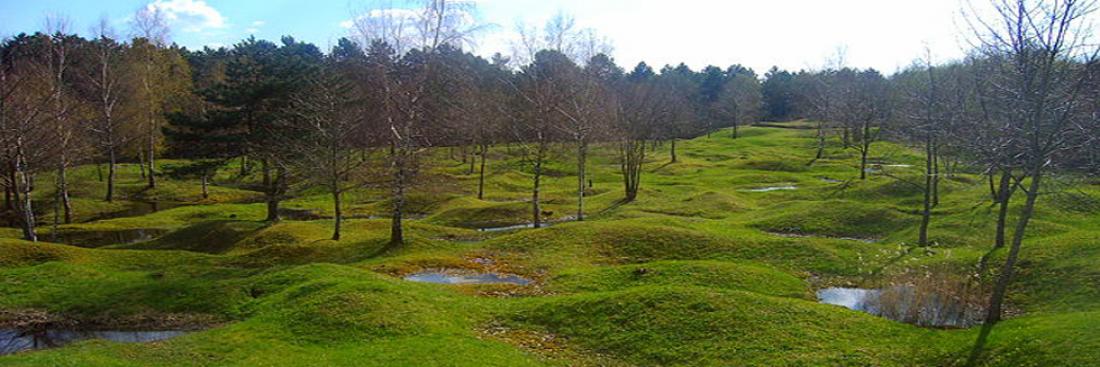
Corps 1
The Western front's theatres of operations In early 1916 the Western front was divided into two parts: the first, from the North Sea to the Somme, was the Anglo-Franco-Belgian sector, which included 39 British, 18 French and six Belgian divisions. The British Expeditionary Corps made up most of the forces. General Douglas Haig replaced Marshal French as commander on 19 December 1915. The entirely French sector, stretching from the Somme to the Swiss border, included most of the French army, with 87 line and reserve divisions. It was made up of three army groups: the North, the East and the Centre, on which the Région Fortifiée de Verdun (R.F.V.) depended. They were under the command of Generals Foch, Langle de Cary and Dubail, respectively. On 6 December 1915 the Allies met at General Joffre's general headquarters (GHQ) in Chantilly to spell out their military objectives. Closing ranks, they decided to keep the Germans guessing with partial local actions and to break through their lines. To achieve those goals, in late December Haig and Joffre agreed on a sweeping Franco-British offensive on the Somme under General Foch's command. But the German attack on Verdun changed the implementation of those objectives.
Corps 2
Verdun
Why Verdun? Von Falkenhayn, the German chief of staff, was in a position of strength and decided to launch the army of the Kronprinz, the Prussian prince and heir to the German empire, in an attack on Verdun.
At Verdun the front formed a salient, making it easier to launch converging attacks from two sides. What's more, the River Meuse cut the battlefield in half, making it harder for the French to defend their position. To make matters worse, the forts of the Verdun Fortified Region were badly organised, without liaison and coverage works between them. The general staff, no longer believing in the virtues of permanent fortifications after the Germans crushed and took the forts of Liège, Namur and Manonvillers in 1914, had stripped them of nearly all their artillery pieces. In August 1915, 43 heavy batteries with nearly 130,000 shells and 11 batteries of light artillery left Verdun for the Champagne front. On the eve of the attack, the German forces faced an enemy whose means of defence had been weakened and whose forts had been stripped of their artillery. In addition to those tactical advantages, the Germans had a key asset: a major communications network (seven railways and the proximity of the formidable entrenched camp in Metz). In contrast, the French could only use three supply routes: two railways-the one from Sainte-Ménehould that was cut off at the beginning of the fighting and the small, narrow-gauge "Meusien"-and the departmental road from Bar-le-Duc to Verdun. The defence of Verdun was therefore severely lacking in artillery and means of communication, whereas the German forces enjoyed overwhelming tactical and logistical superiority. Verdun was also important for psychological reasons. On 14 February 1916 the Kaiser issued a proclamation to his troops glorifying the imminent attack: "I, William, see the German Fatherland forced to go on the offensive. The people want peace; but to establish peace a decisive battle must conclude the war. Verdun, the heart of France, is where you shall harvest the fruit of your efforts...". Another goal of the taking of Verdun, then, was the collapse of the French army's morale for, as Marshal Pétain wrote later, "Verdun was not just a big fortress in the East intended to block an invasion, it was the moral boulevard of France". (1) General von Falkenhayn's initial objective was to take the town in order to clear the way for an invasion. It is highly unlikely that he anticipated waging a battle of attrition. In fact, the failure of his first attempts to break through the French lines and the battle's overall conditions are what led him adopt a strategy of wearing down the enemy. The German general staff had the advantage in attacking Verdun and Falkenhayn pulled out all the stops to prepare his decisive offensive. In front of Verdun the Germans concentrated the heavy artillery pieces that had crushed the Allies' fortified positions in 1914: the 5th Army's twenty-five 305 and 420mm mortars, three 380mm navy guns and 1,200 cannons. The Germans had 600,000 shells, the French 6,400. The German artillery was poised to unleash a bombardment the likes of which had never been seen. It was carefully organised so that all the infantry had to do was occupy already-conquered ground.
The German attack: the right bank, 21 February-5 March At dawn on 21 February the Germans unleashed a bombardment on an unprecedented scale that lasted until 5:15pm French time(2). On the right bank, 80,000 Germans, believing that nothing could stand in their way after such a deluge of fire and steel, stormed the French positions. Much to their surprise, some French units, like Lieutenant-Colonel Driant's 56th and 59th infantry battalions at Caures Wood, put up fierce resistance.
The Germans' advance was weak and uneven until 24 February, but the French front cracked on the 25th. The enemy suddenly broke through between Meuse and Woëvre. At the end of the day Douaumont Fort, stripped of most of its artillery pieces and defended by just 58 men, easily fell into the hands of Second Lieutenant Brandis's and Captain Haupt's 24th Brandenburg regiment, making them national heroes in Germany overnight. On the evening of the 25th, France lost its most modern fort and, above all, a key observatory. The Germans were just 5km from Verdun. Joffre gave General de Castelnau full powers and urgently sent him to Verdun to prevent a complete break in the French lines and a catastrophic retreat. On 24 February he ordered the right bank of the Meuse, north of Verdun, to hold out: "Any officer who under the present circumstances gives an order to retreat will be court-martialled". (3) Then he decided to dissolve the R.F.V. and replace it with the 2nd army, which he put under the command of General Pétain (4) with the mission of organising the defence of Verdun.
Pétain and the organisation of defence As soon as General Pétain reached his new headquarters in Souilly, 20km from Verdun, he set about planning for the battle. The first steps involved the forts, which became the main centres of resistance. Each had its own command, garrison and large stocks of material reserves. It was absolutely forbidden to surrender in case of an enemy attack. Then Pétain mobilised the artillery, which was to relieve the infantry by concentrating its fire on the German positions but also played a defensive role by crushing the enemy's attacks. Throughout the Battle of Verdun, Pétain never stopped saying, "the artillery must give the infantrymen the impression that it supports them and that it is not being dominated".
But the main achievement was the organisation of logistical transport and means of replenishing supplies. After an article by Maurice Barrès, the departmental road from Bar-le-Duc to Verdun became known as the "Sacred Way" because it was the main link between Verdun and the rear. In order to keep 2,900 lorries moving on the road in both directions every day, Pétain had quarries opened up alongside it. Teams of territorial troops and Indochinese auxiliaries ceaselessly threw shovelfuls of stones under the wheels of the lorries, which passed by at the rate of one every five seconds. Some 70,000 tonnes of stones were used without interrupting traffic. Replenishing Verdun's supplies on the Sacred Way was a huge undertaking: every day the 300 officers, 8,000 men, 2,000 cars, 200 buses and 800 ambulances of the Commission Régulatrice Automobile carried an average of 13,000 men, 6,400 tonnes of equipment and 1,500 tonnes of munitions, consuming two tonnes of grease, 20,000 litres of oil and 200,000 litres of fuel. The little "Meusien" railway also supplied the 2nd Army. Every day the Saint-Dizier regulating station sent 21 trains of foodstuffs, seven of munitions, nine of equipment and two of troops to Verdun, as well as evacuated five to seven trains of wounded. Altogether, 119,000 railroad cars travelled the route between 21 February and 1 June(5). The defence of Verdun organised by Pétain foiled Falkenhayn's plans. He stopped the right-bank offensive on 5 March. The next day, the German troops launched a massive attack on the left bank: the battle of attrition was under way. It took on a character unique in history.
The course and original characteristics of the Battle of Verdun (March-July 1916) From 5 March to 15 July the Germans remained in strategic control of the battle by regularly alternating its offensives on both banks of the Meuse. On the left bank, German troops took Goose Hill, Avocourt, Malancourt and Béthincourt in the 6 March attack; on the 10th General Pétain issued his famous order of the day to the troops: "Courage! We'll get them...". On 9 April the German army dug in on the north flanks of Hill 304 and Mort-Homme. The French front held the main points of resistance set by General Pétain only at the price of very heavy casualties. Pétain stood out by his caution. In La France et son armée, General de Gaulle wrote that he was "excellent at grasping the essentials" and avoided useless casualties as much as possible." But on 1 May General Nivelle replaced him as commander of the Second Army and he became head of the group of armies of the Centre. Joffre wanted that promotion because it was actually a means of pushing Pétain aside by taking direct responsibility for operations away from him.
The Germans were still in control of the terrain and thwarting the French army's deep counter-thrusts, such as the one on 22 May when General Mangin's 5th Infantry Division stormed Douaumont Fort. The French infantrymen did not have the resources they needed to take the fort. Taking heart from that failure, the Germans pursued their offensives. They began an atrocious five-day siege of Vaux Fort, which they totally encircled. After Major Raynal's men ran out of munitions, food and water-some were so thirsty they drank their own urine-the Germans attacked them with gas and flame-throwers. The fort surrendered on 7 June. The Germans launched offensives during the rest of the summer. After extremely violent fighting, they took the right bank, Thiaumont farm and defence works, village of Fleury and Froideterre defence works (6). The Germans were just three km from Verdun and the French had to send in a steady stream of reinforcements to hold the front. By late June 70 divisions making up three-fourths of the French army had fought or were fighting at Verdun. Pétain was short of men and had to organise the "tourniquet"-quick, frequent changes of units- "so that the same men do not stay on the battlefield too long, at the risk of seeing both their numbers and their morale collapse."(7). France had an ambiguous perception of the unimaginably fierce fighting. On the one hand, newspapers, but also other sources, manufactured an idealistically heroic aura around the battle intended for popular consumption. On the other, eyewitness accounts and letters to families from the men on leave who were doing the actual fighting painted a grim, heart-wrenching picture. The horrors of Verdun actually drove a deep wedge between combatants and non-combatants. French soldiers scarcely appreciated the image they were being given and resented the home front's inability to measure their suffering, which they themselves could find no words to describe. Nevertheless the rear gradually became more accurately informed about the appalling reality of life at the front. In a sign that perceptions were shifting, Henri Barbusse's book Under Fire won the 1916 Goncourt Prize.
From a tactical standpoint, the Battle of Verdun was unique in the Great War's history. Verdun was a crucible, a furnace, a steamroller with no front, trenches or shelters. The lines of defence were nothing more than scattered positions constantly under attack or isolated units completely left to their own devices because they had lost most of their officers. They knew there was only one solution: "to hold on". They had to fight day and night, covered in mud at the bottom of foxholes, broiling in the heat or freezing in the cold, usually without food or water.
French soldiers at Verdun fought in conditions of unprecedented ghastliness. The bodies of two out of three who died there were never found because, on a battlefield where one shell fell for every square meter, the victims were soon pulverised or buried. The well-organised defence and soldiers' high morale enabled the French army to hold out. By early July the 5th German army was exhausted by the great June offensive (the battles of Hill 304 and Mort-Homme on the left bank; the taking of Vaux Fort, the Thiaumont farm and the village of Fleury on the right bank) and had lost nearly as many men as the French. The German assault units seem to have melted away. For example, the 2nd Bavarian division lost 80% of its infantry. Bled white, the Germans launched their final attack on 11 July but ran out of steam and failed in front of Souville Fort, the last French bulwark before Verdun. The next day, Falkenhayn had to give up on the idea of an offensive, especially since he had to shift regiments and artillery to the Somme, Russia and Romania. The relief of Verdun (October-December 1916) The German divisions' exhaustion at Verdun and troop transfers to other fronts stopped the enemy offensive in mid-July. The German general staff lost control of the situation. Later, General Ludendorff described Verdun in his memoirs as "a gaping wound that ate away at our forces". In early September Nivelle and Pétain developed plans to break through the German positions on the right bank. They focused on strengthening the artillery's firepower, in particular by using French 370 and 400mm howitzers for the first time at Verdun. The French pounded the right bank from 20 to 23 October. At dawn on the 24th four divisions commanded by General Mangin stormed Douaumont. The failure to take back the fort on 22 May served as a lesson: this time, the offensive focused not just on that sector but also on a much wider area. The colonial infantry regiment of Morocco and parts of the 321st R.I. overran the ruins and held onto them. A week later the Germans evacuated Vaux Fort, which French troops reoccupied. On 15 December a new operation pushed back the German front 5km north of the Côte du Poivre-Louvemont-Bois des Caurières-Bezonvaux line. By late 1916 French troops had taken back the ground lost since 21 February on the right bank of the Meuse north of Verdun: the town was relieved. From February to December 162,000 Frenchmen perished in the Battle of Verdun, which also cost the lives of 143,000 Germans.
Note:
(1) Maréchal Pétain, La Bataille de Verdun. Paris, Payot, 1929, p. 9 (2) 4:15pm, German time (3) Text quoted in Jules Poirier, La Bataille de Verdun. Paris, 1922. Chiron (4)In 1914 the 58-year-old, about-to-retire Pétain was an almost totally unknown colonel commanding an infantry regiment. The war changed his plans by quickly making him a general. The Battle of Verdun made him one of the Great War's most famous generals. (5) In order to supply the troops with so much equipment, the French had to set up many munitions dumps. Some of them exploded, causing terrible tragedies on both sides. For example, the Tavannes tunnel fire on the night of 4-5 September killed over 500 French soldiers, who were burned alive or asphyxiated. On 8 May a grenade dump blew up in Douaumont Fort, which was then in German hands, killing nearly 680 soldiers, who lie buried in a casemate transformed into a funerary chapel. (6) Fleury and the Froideterre fortification works changed hands 16 times. (7) Marshal Pétain, op. ci
Personalities
Related articles
- Le Combattant de Verdun d'après L'Illustration
- Allocution prononcée par M. Maurice Genevoix
- Attaque allemande du 23 juin 1916 sur Verdun
- The Battle of Bois des Caures
- The situation in Germany in early 1916
- Le 158e Régiment d'Infanterie à Verdun
- Les gendarmes dans la bataille de Verdun
- Les marraines de guerre
- Lettres Marquis de Lespinay
- L'évolution des armes portatives au cours de l'année 1916
- Récit du Docteur Léon Bonnet
- Verdun : l'aspect du champ de bataille
- Verdun : les évolutions de la mémoire d'une bataille symbolique
- Verdun - 8 mars 1916 -Témoignage
- La nuit au Mort Homme
- Les enjeux de la Voie Sacrée
- The Battle of Bois des Caures


